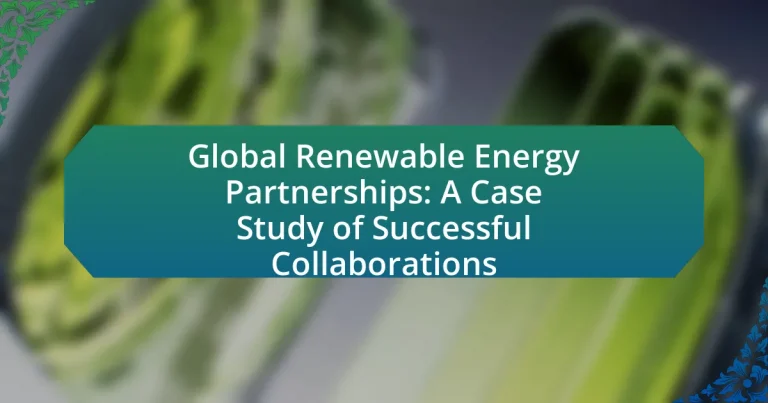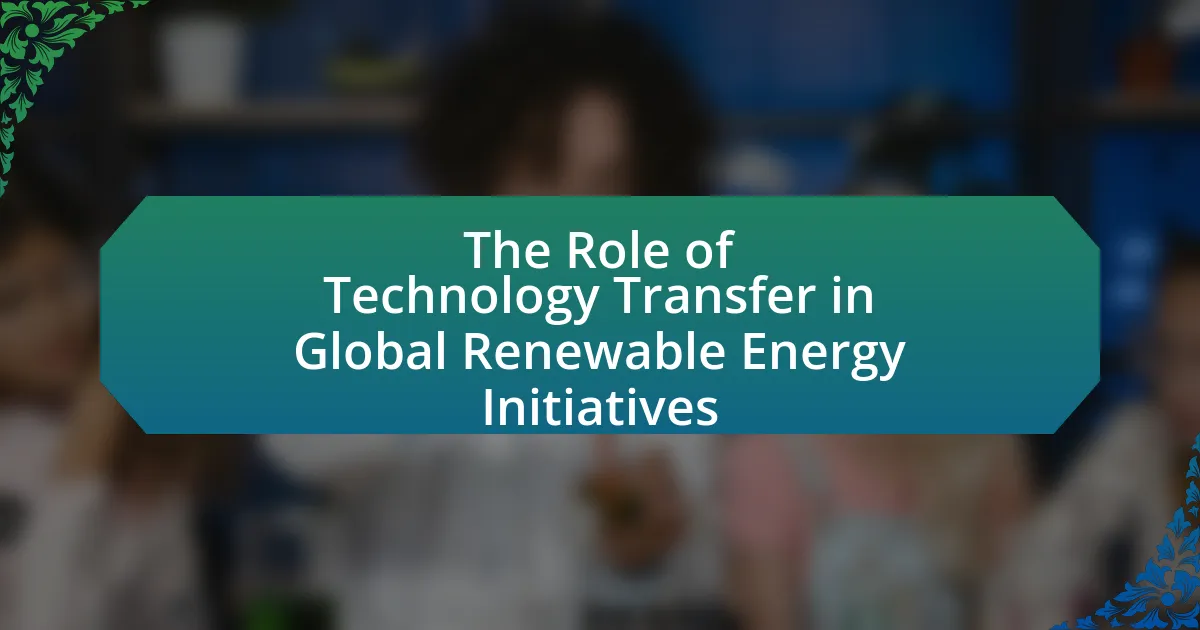Global Renewable Energy Partnerships are collaborative initiatives that unite countries, organizations, and private sectors to advance renewable energy technologies. This article explores the formation, operation, and significance of these partnerships, highlighting key stakeholders such as government agencies, private companies, NGOs, and local communities. It examines successful examples like the International Solar Alliance and the Clean Energy Ministerial, detailing their impact on global energy transitions and sustainable development goals. Additionally, the article addresses challenges faced by these partnerships and offers strategies for enhancing collaboration and ensuring long-term sustainability.
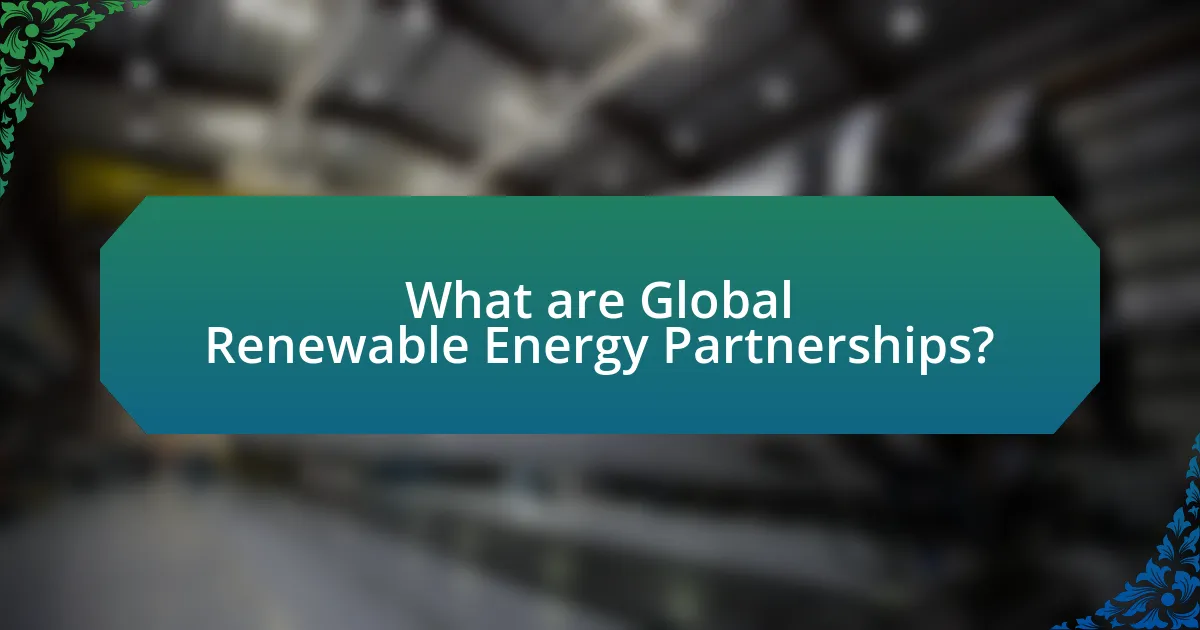
What are Global Renewable Energy Partnerships?
Global Renewable Energy Partnerships are collaborative initiatives between countries, organizations, and private sectors aimed at promoting the development and deployment of renewable energy technologies. These partnerships facilitate knowledge sharing, resource mobilization, and joint investment in renewable energy projects, thereby accelerating the transition to sustainable energy systems. For instance, the International Renewable Energy Agency (IRENA) has established various partnerships that have led to significant advancements in solar and wind energy deployment across multiple nations, demonstrating the effectiveness of collaborative efforts in achieving global energy goals.
How do these partnerships form and operate?
Partnerships in global renewable energy typically form through mutual interests in sustainability, resource sharing, and technological innovation. Organizations, governments, and private entities identify common goals, such as reducing carbon emissions or enhancing energy efficiency, which leads to collaborative agreements. These partnerships operate by establishing frameworks for resource allocation, joint research initiatives, and shared investments in renewable technologies. For instance, the International Renewable Energy Agency (IRENA) facilitates partnerships by providing platforms for dialogue and collaboration among member countries, which enhances knowledge sharing and project implementation.
What are the key stakeholders involved in these partnerships?
The key stakeholders involved in global renewable energy partnerships include government agencies, private sector companies, non-governmental organizations (NGOs), and local communities. Government agencies play a crucial role by setting policies and regulations that facilitate renewable energy projects. Private sector companies contribute investment, technology, and expertise necessary for project implementation. NGOs often advocate for sustainable practices and represent community interests, ensuring that local perspectives are considered. Local communities are essential as they provide support and resources, and their engagement is vital for the success and acceptance of renewable energy initiatives.
What roles do governments and private sectors play in these collaborations?
Governments play a crucial role in global renewable energy partnerships by establishing regulatory frameworks, providing funding, and facilitating international agreements, while private sectors contribute through innovation, investment, and technology development. For instance, government policies can incentivize renewable energy projects, as seen in countries like Germany, where feed-in tariffs have significantly boosted solar energy adoption. Simultaneously, private companies, such as Tesla, drive advancements in battery technology, which is essential for energy storage solutions. This collaboration between public policy and private innovation is vital for achieving sustainable energy goals and addressing climate change effectively.
Why are Global Renewable Energy Partnerships important?
Global Renewable Energy Partnerships are important because they facilitate collaboration among countries, organizations, and businesses to accelerate the transition to sustainable energy systems. These partnerships enable the sharing of technology, knowledge, and resources, which can lead to increased investment in renewable energy projects. For instance, the International Renewable Energy Agency (IRENA) reported that global investments in renewable energy reached $282.2 billion in 2019, demonstrating the financial impact of such collaborations. Additionally, these partnerships help to address climate change by promoting cleaner energy sources, thereby reducing greenhouse gas emissions and fostering energy security worldwide.
What impact do these partnerships have on global energy transition?
Partnerships in global renewable energy significantly accelerate the energy transition by fostering collaboration, sharing resources, and enhancing technological innovation. These collaborations enable countries and organizations to pool financial investments and expertise, leading to the rapid deployment of renewable technologies. For instance, the International Renewable Energy Agency (IRENA) reported that collaborative efforts can reduce the cost of renewable energy technologies by up to 30% through shared research and development. Additionally, partnerships facilitate knowledge transfer and capacity building, which are crucial for developing countries to adopt sustainable energy practices effectively.
How do they contribute to sustainable development goals?
Global renewable energy partnerships contribute to sustainable development goals by facilitating access to clean energy, promoting economic growth, and fostering innovation. These collaborations enable countries to share technology and resources, which accelerates the transition to renewable energy sources, directly supporting Goal 7 (Affordable and Clean Energy) and Goal 13 (Climate Action). For instance, the International Renewable Energy Agency reported that renewable energy could create up to 24 million jobs globally by 2030, demonstrating the economic benefits of these partnerships. Additionally, initiatives like the Clean Energy Ministerial showcase how countries can work together to enhance energy efficiency and reduce greenhouse gas emissions, further aligning with multiple sustainable development goals.
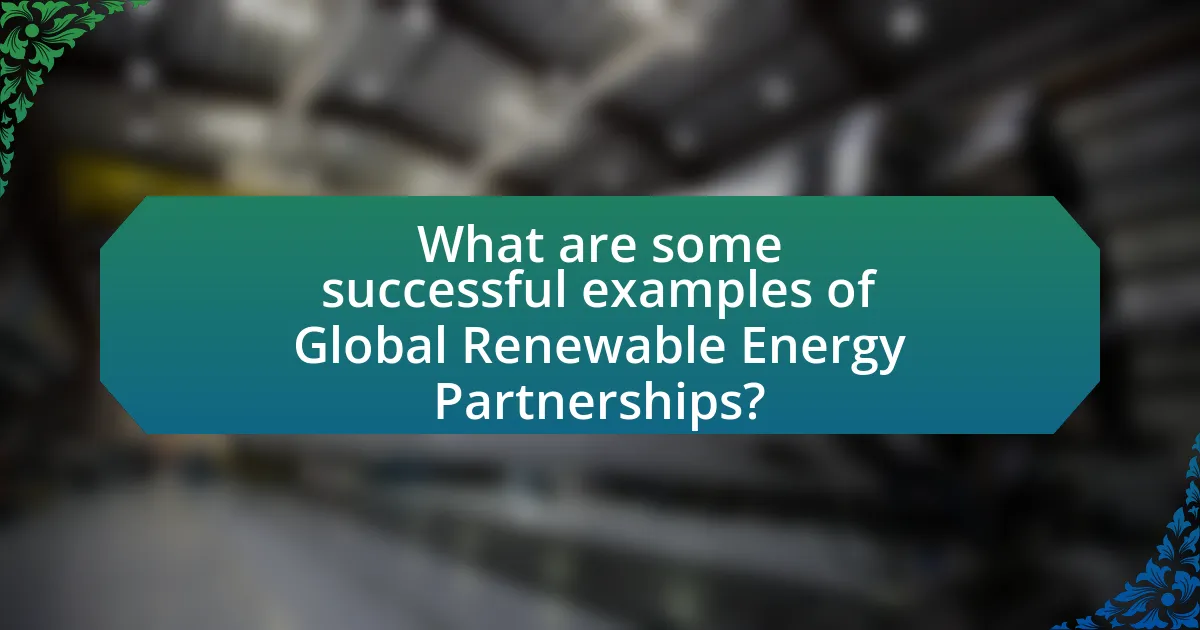
What are some successful examples of Global Renewable Energy Partnerships?
Some successful examples of Global Renewable Energy Partnerships include the International Solar Alliance (ISA) and the Clean Energy Ministerial (CEM). The ISA, launched in 2015, aims to promote solar energy deployment and has over 120 member countries, facilitating collaboration on solar technology and financing. The CEM, established in 2010, brings together 25 countries to advance clean energy technologies and policies, focusing on energy efficiency and renewable energy innovation. Both partnerships have demonstrated effectiveness in mobilizing resources and fostering international cooperation to accelerate the transition to renewable energy.
How have specific partnerships achieved their goals?
Specific partnerships in global renewable energy have achieved their goals by leveraging shared resources, expertise, and technology to enhance project efficiency and impact. For instance, the collaboration between the International Renewable Energy Agency (IRENA) and various governments has led to the establishment of renewable energy targets and policies that have resulted in a 50% increase in global renewable energy capacity from 2010 to 2020. Additionally, partnerships like the one between the Solar Energy Industries Association (SEIA) and the U.S. Department of Energy have facilitated research and development initiatives that have driven down solar energy costs by over 80% since 2010, making solar power more accessible and affordable. These collaborations exemplify how strategic alliances can effectively mobilize resources and knowledge to meet renewable energy objectives.
What strategies did these partnerships employ to overcome challenges?
These partnerships employed collaborative frameworks, resource sharing, and innovative technology integration to overcome challenges. By fostering open communication and establishing clear goals, they effectively aligned their objectives and resources. For instance, partnerships often shared financial investments and technical expertise, which enabled them to tackle high upfront costs and complex regulatory environments. Additionally, leveraging cutting-edge technologies, such as smart grids and energy storage solutions, allowed these collaborations to enhance efficiency and reliability in renewable energy deployment.
What measurable outcomes resulted from these collaborations?
The measurable outcomes from these collaborations include a significant increase in renewable energy capacity, with partnerships leading to the installation of over 150 gigawatts of solar and wind energy globally. Additionally, these collaborations have resulted in a reduction of greenhouse gas emissions by approximately 200 million tons annually, demonstrating a direct impact on climate change mitigation. Furthermore, the partnerships have generated over 500,000 jobs in the renewable energy sector, contributing to economic growth and sustainability. These outcomes are supported by data from the International Renewable Energy Agency, which highlights the effectiveness of collaborative efforts in advancing renewable energy initiatives.
What lessons can be learned from these successful collaborations?
Successful collaborations in global renewable energy partnerships demonstrate the importance of shared goals and mutual benefits. These partnerships often lead to innovative solutions that address common challenges, such as climate change and energy access. For instance, the collaboration between countries and private sectors has resulted in significant advancements in solar and wind technologies, showcasing how pooling resources and expertise can accelerate progress. Additionally, effective communication and trust among partners are crucial, as evidenced by the success of initiatives like the International Solar Alliance, which fosters cooperation among nations to enhance solar energy deployment. These lessons highlight that strategic alliances, clear objectives, and open dialogue are essential for achieving impactful outcomes in renewable energy initiatives.
What best practices emerged from these case studies?
Best practices that emerged from the case studies on global renewable energy partnerships include fostering strong stakeholder engagement, establishing clear communication channels, and leveraging local knowledge. Stakeholder engagement ensures that all parties, including governments, NGOs, and local communities, are involved in decision-making processes, which enhances project acceptance and sustainability. Clear communication channels facilitate transparency and trust among partners, leading to more effective collaboration. Leveraging local knowledge allows projects to be tailored to specific regional needs and conditions, increasing their effectiveness and efficiency. These practices have been validated through successful projects that demonstrated improved outcomes and stakeholder satisfaction.
How can these lessons be applied to future partnerships?
The lessons learned from successful global renewable energy partnerships can be applied to future collaborations by emphasizing the importance of clear communication, shared goals, and mutual benefits. For instance, partnerships that established transparent communication channels and aligned objectives, such as the collaboration between the International Renewable Energy Agency and various countries, demonstrated increased project efficiency and stakeholder engagement. This approach can be replicated in future partnerships to ensure all parties are on the same page, thereby reducing misunderstandings and enhancing project outcomes. Additionally, focusing on mutual benefits, as seen in the partnership between private companies and governments, can foster long-term relationships and commitment, which are crucial for the sustainability of renewable energy initiatives.
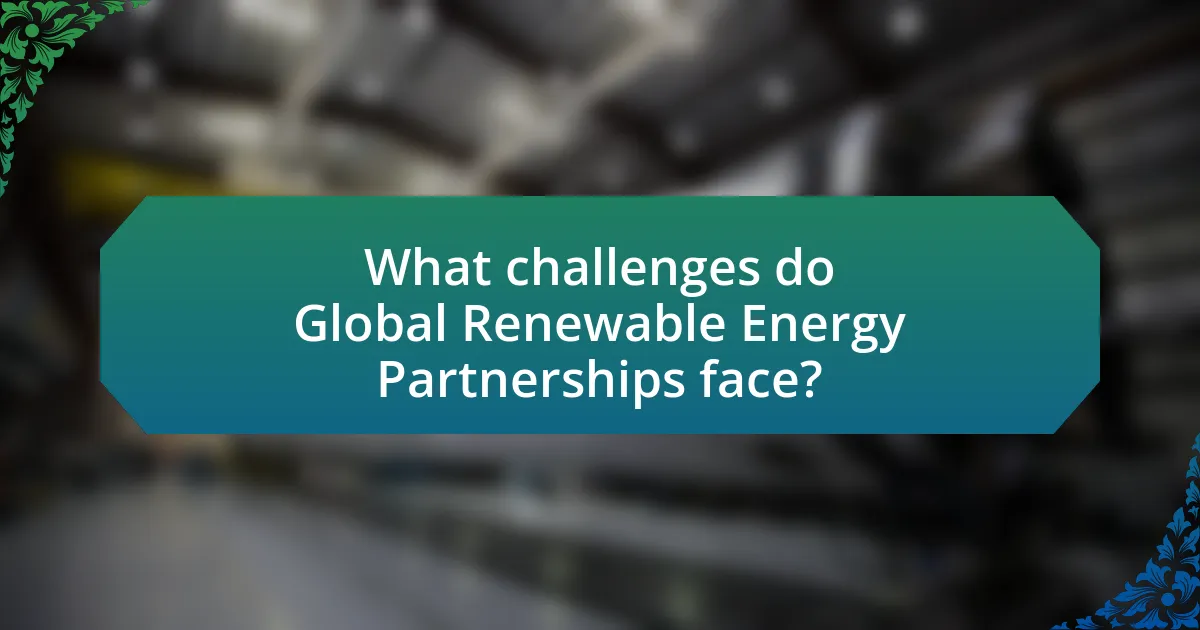
What challenges do Global Renewable Energy Partnerships face?
Global Renewable Energy Partnerships face several significant challenges, including regulatory barriers, financing issues, and technological disparities. Regulatory barriers often arise from differing national policies and standards, which can hinder collaboration and project implementation. Financing issues are prevalent as securing investment for large-scale renewable projects can be difficult, particularly in developing regions where financial markets may be underdeveloped. Additionally, technological disparities exist between countries, affecting the ability to share and implement advanced renewable technologies effectively. These challenges can impede the progress and success of partnerships aimed at promoting renewable energy initiatives globally.
What are the common obstacles encountered in these collaborations?
Common obstacles encountered in global renewable energy partnerships include differing regulatory frameworks, cultural misunderstandings, and financial constraints. Regulatory frameworks vary significantly across countries, which can hinder collaboration by creating compliance challenges. Cultural misunderstandings may lead to miscommunication and conflict among partners from diverse backgrounds. Financial constraints often limit the ability to invest in necessary technologies or infrastructure, impacting the overall success of the collaboration. These obstacles have been documented in various studies, highlighting the need for clear communication and aligned objectives to overcome them effectively.
How do political and economic factors influence these partnerships?
Political and economic factors significantly influence global renewable energy partnerships by shaping regulatory frameworks and investment climates. Political stability and supportive government policies, such as subsidies or tax incentives for renewable energy projects, encourage collaboration between countries and private entities. For instance, the European Union’s Renewable Energy Directive promotes cross-border partnerships by setting binding targets for renewable energy use, fostering cooperation among member states. Economically, access to funding and market opportunities drives partnerships; countries with robust economies can attract foreign investment, as seen in China’s Belt and Road Initiative, which facilitates renewable energy projects in developing nations. These factors create an environment conducive to collaboration, ultimately enhancing the effectiveness and reach of renewable energy initiatives.
What role does technology play in the success or failure of these partnerships?
Technology is crucial in determining the success or failure of global renewable energy partnerships. It facilitates efficient communication, data sharing, and project management among partners, which enhances collaboration and decision-making. For instance, advanced software tools enable real-time monitoring of energy production and consumption, allowing partners to optimize resource allocation and improve project outcomes. Additionally, innovations in renewable energy technologies, such as solar panels and wind turbines, directly impact the feasibility and effectiveness of joint initiatives. According to a report by the International Renewable Energy Agency, partnerships that leverage cutting-edge technology can increase project efficiency by up to 30%, demonstrating that technology is a key driver of success in these collaborations.
How can these challenges be addressed effectively?
To address the challenges in global renewable energy partnerships effectively, stakeholders must prioritize transparent communication and establish clear objectives. Transparent communication fosters trust among partners, which is essential for collaboration. For instance, the International Renewable Energy Agency (IRENA) emphasizes that effective dialogue can lead to better alignment of goals and resources, ultimately enhancing project outcomes. Additionally, setting measurable objectives allows partners to track progress and make necessary adjustments, as demonstrated by the success of the Clean Energy Ministerial, which has facilitated international cooperation and innovation in renewable energy technologies.
What strategies can be implemented to enhance collaboration?
To enhance collaboration in global renewable energy partnerships, organizations can implement strategies such as establishing clear communication channels, fostering trust through transparency, and setting shared goals. Clear communication channels ensure that all stakeholders are informed and engaged, which is critical for effective collaboration. Transparency builds trust among partners, as it allows for open sharing of information and resources. Setting shared goals aligns the interests of all parties involved, creating a unified direction for the partnership. Research indicates that partnerships with defined objectives and open communication are more likely to succeed, as evidenced by the International Renewable Energy Agency’s findings on collaborative projects in renewable energy sectors.
How can stakeholders ensure long-term sustainability of these partnerships?
Stakeholders can ensure long-term sustainability of partnerships in global renewable energy by establishing clear, shared goals and maintaining open communication. Clear goals align the interests of all parties, fostering commitment and collaboration. Open communication facilitates transparency, allowing stakeholders to address challenges promptly and adapt strategies as needed. Research indicates that partnerships with defined objectives and regular dialogue are more likely to succeed; for instance, a study by the International Renewable Energy Agency found that effective communication and shared vision significantly enhance partnership longevity.
What practical steps can organizations take to foster successful Global Renewable Energy Partnerships?
Organizations can foster successful Global Renewable Energy Partnerships by establishing clear communication channels and aligning goals among partners. Effective communication ensures that all stakeholders understand their roles and responsibilities, which is crucial for collaboration. Additionally, organizations should conduct thorough market research to identify potential partners with complementary strengths and shared values, enhancing synergy. Implementing joint projects with measurable outcomes can also solidify partnerships, as evidenced by the International Renewable Energy Agency’s report highlighting successful collaborations that led to increased renewable energy capacity in various regions. Furthermore, organizations should prioritize capacity building and knowledge sharing, as demonstrated by the Global Wind Energy Council’s initiatives that have empowered local communities through training and resources.
